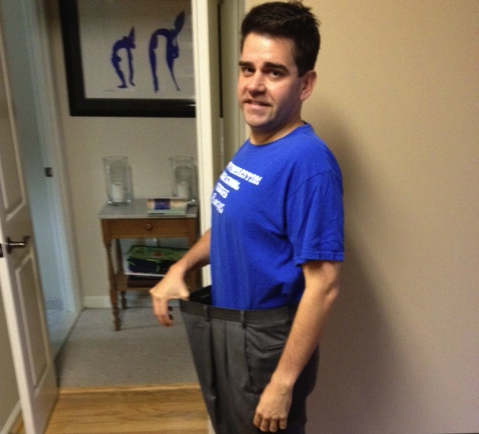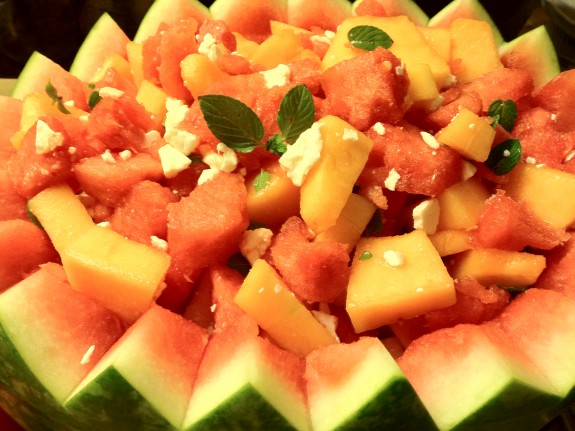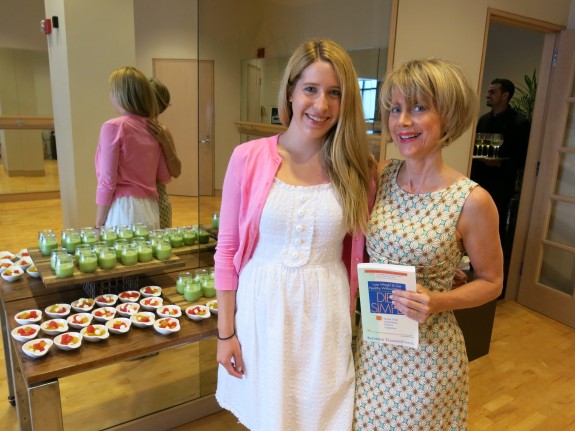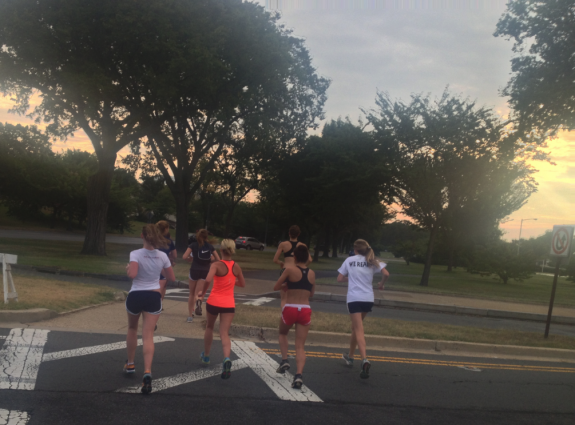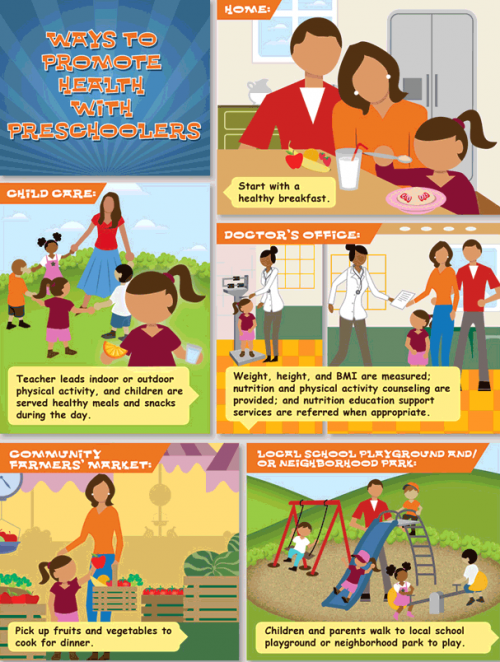Two Large Meals (Breakfast & Lunch) are Best at Controlling Weight
- At May 21, 2014
- By Katherine
- In Articles, News
 2
2
- Mark Indre began eating a larger breakfast and a lighter dinner… “I have lost more than 35 pounds and have kept it off for more than two years with Katherine’s Diet Simple program.”
A new study confirmed what I’ve suspected for the twenty (or more) years I’ve been a diet counselor. Eating hearty meals earlier in the day instead of in the evening leads to weight loss and better health, even when the same foods and same calories are eaten.
A recent study published in the scientific journal, “Diabetologia,” found people with Type 2 Diabetes eating a large breakfast and lunch – and no dinner, as compared with those eating six small meals with the same calories – lost more body fat, liver fat, and improved insulin sensitivity.
That’s not to say you shouldn’t be eating dinner, as scientists often exaggerate conditions to get measurable results in their studies. But you can likely use the study’s conclusions to make positive changes for your health and weight, as did my client, Mark Indre.
“I lost more than 35 pounds and have kept it off for more than two years,” said Mark Indre.
Some points to consider…
Does this sound familiar? You get home from work, stressed and ravenous. You head straight for the kitchen, grab a bowl of nuts or a plate of cheese and crackers. You nibble as you’re preparing dinner. After dinner, you settle on the couch, most likely in front of the television, and zone out with some favorite snacks, such as popcorn, chips, nuts, ice cream, peanut butter or sweets—whatever is tasty and easy to grab.
Welcome to the typical American evening! For many people, it’s an endless graze that doesn’t stop until they go to bed.
Evening overeating is an issue that contributes to many peoples’ weight problems. I’ve been surprised at just how many people struggle with this. I used to myself. Even disciplined people who carefully watch their intake during the day break down at night. I can’t count how many times I’ve heard these refrains: “I’m fine during the day, my problem’s at night,” or “If I could control my eating at night, my weight problem would probably disappear…. ”
This is important because more and more research is confirming the importance of eating lighter at night and heavier during the day – for health, not just weight. A recent study published in “Diabetologia” found people who at a large breakfast and lunch – and no dinner, as compared with people with type 2 diabetes who ate 6 small meals – lost body fat and improved insulin sensitivity. This occurred while eating the same calories, just distributed differently.
It’s become clear to me that evening overeating is not just an isolated problem but the convergence of a host of lifestyle issues—stress, exhaustion, loneliness, disorganized eating and hunger.
In today’s fast-paced world, many people are constantly hopping from meeting to meeting or from chore to chore during the day and don’t have time to sit down and eat a decent meal. So we become ravenous. In the evening, there’s more time for eating, so we not only eat larger meals, but continuous ones. Those who are tired or stressed find that food is an easy way to reward themselves at the end of the day. Food can provide a little companionship for the lonely or depressed. Researchers who have identified “night eating syndrome,” the most severe form of evening overeating that affects about five percent of obese people seeking treatment, say it is stress-related.
“We believe it’s a stress disorder which causes people to eat more than one-third of their calories after the evening meal,” says obesity researcher Albert J. Stunkard, who has studied nighttime overeaters since the 1950s and recently co-authored “Overcoming Night Eating Syndrome: A Step-by-Step Guide to Breaking the Cycle” (New Harbinger Publications, 2004).
Evening overeating is an important problem to solve because Americans who eat most of their daily intake of food at night eat more overall calories, according to a study reported in the Journal of Nutrition. And that makes them more susceptible to weight problems.
“The late-night period was when the highest-density foods were eaten. Eating a high proportion of daily intake in the late evening, compared to earlier in the day, was associated with higher overall intake,” researcher John M. de Castro concluded in the study, which analyzed food diaries of about 900 men and women.
De Castro, professor and chair of the department of psychology at the University of Texas at El Paso, also found that evening eating was less satisfying for people, which may help explain why they eat more.
“In the evening, you get lower satiety. People tend to eat very large meals but then eat again shortly afterward,” said de Castro.
For those who succumb to nighttime overeating, I recommend you attack this problem by assessing why this may be happening to you and then devising specific personalized strategies for eating lighter at night. Some points to consider:
Breakfast: De Castro’s study found that a “high proportional intake in the morning is associated with low overall daily intake.” This finding confirms my experience of 25+ years: Eating a bigger breakfast is the single most effective way of curbing evening overeating. Other studies have confirmed the importance of breakfast for maintaining weight loss.
I advise my clients to eat one-third of their daily calories in the morning. For most people, that’s at least 600 calories, much more than they’re used to consuming.
While solving other issues such as end-of-day stress, exhaustion and emotional issues are important, too, I’ve found that nothing works unless morning eating is beefed up first. Eating more in the morning is a scary proposition for many people who fear that they’ll continue their evening overeating on top of the bigger breakfast. But my clients who bite the bullet and give it a try are amazed to find that it reduces cravings and gives them a sense of control, so that it is easier to eat more moderately later in the day.
Interestingly, de Castro found that people are more sated with the food they eat in the morning. “If they eat a large breakfast, they’ll wait a long time before eating again. They get a lot of bang for the buck,” says de Castro.
Organized eating: Researchers have found that most people with the more severe “night-eating syndrome” don’t have regular meal and snack times. I have also found this is true for evening overeaters. Most overeating is due simply to undereating throughout the day and poor planning. I hear so many people say “I have no will power,” or “I hate myself because I have no discipline.” But they somehow regain their “discipline” and “will power” by simply planning and eating regular daytime meals and snacks.
That’s why I advocate cooking in large batches and regular grocery shopping so that you have healthy and delicious foods at your fingertips when you get home from work in the evenings.
Trigger foods: Many people who overeat in the evenings have “trigger” foods, specific foods they crave and are more likely to overeat, such as chips, chocolate or peanut butter. The experts find the avoidance of trigger foods can reduce evening overeating.
Assessing hunger: Your body lets you know what it needs. One key to lasting weight management is being in touch with your body and its signals. In the evening, before eating, get rid of distractions, take a few deep breaths and stop to think if you’re physically hungry. If you’re hungry, eat. If you’re not, or if you’re not sure, you shouldn’t eat.
Stress management: Many people overeat in the evenings as a way to cope with the stress and exhaustion they may feel or to reward themselves at the end of a hard day. But this is a self-defeating response to stress or rewards. When you come home, never head straight for the kitchen. Instead, hop in the shower or tub to decompress, take a walk or stretch. Once relaxed, then decide what you’d like for dinner. Better yet, hopefully you’ve already planned your dinner.
Of course, these actions are only possible if you’ve fed yourself properly during the day and you’re not ravenous.
Reducing behavioral associations: Like Russian scientist Ivan Pavlov’s famous dogs, we can train ourselves to salivate and crave food in connection with just about any activity. Playing cards, eat. Watching a movie, eat. Going to the mall, eat. Talking on the phone, eat. Reading in bed, eat. Watching TV, eat. The experts recommend you eat only when seated at your dining or kitchen table, without distractions, so that you don’t develop an association between eating and any activity, place or person. The only stimulus for eating should be hunger. Distractions tend to reduce inhibitions to overeating.
When to eat: There is no hard-and-fast rule governing the timing of your last meal in the evening. I recommend that evening calories don’t exceed lunch or breakfast calories and that you eat at least two-thirds of your day’s calories before dinner. It’s important to go to bed feeling light, not full. This way, you awake hungry for a big breakfast.
Tired of Blizzard Bloat? Reversing Winter Weight Gain
- At February 24, 2014
- By Katherine
- In Articles, News
 0
0
Have you noticed your weight creeping up this winter? Are you experiencing more cravings than usual, especially for heartier, more fattening foods? Well, take heart. You’re not the only one experiencing “blizzard bloat,” the creeping up of body fat hitting a large number of people during the winter months.
In the animal kingdom, fattening up in winter is critical for survival. Animals overeat to store enough excess fat to survive until spring. The human animal has a similar natural instinct, probably leftover from the days when food was scarce in winter and shivering in the cold caused us to burn our fat stores too quickly, leaving us too thin to survive (aaaah, those were the days!). But now, with temperature control, improved agricultural techniques and a cupcake shop on every corner, that leftover but highly frivolous instinct just causes trouble. Because of modern conveniences, we humans fatten up following the old instincts when we no longer need to!
Though these old instincts are plausible as a cause of winter weight gain, there are more complex—and controllable—causes too. The most important probably involve decreases in both sunlight and physical activity. Together, they can contribute to enough of a calorie imbalance to cause weight gain. Here’s how.
- Sunlight. Some people are particularly susceptible to light deprivation, caused by the decrease in daylight hours during the winter. This affects the neurochemical serotonin, responsible for your mood and appetite, prompting increased food cravings and weight gain.
- Physical Activity. When it’s cold outside, we’re less physically active and cut back on subtle calorie-burning activities such as short walks and light outdoor chores. These caloric expenditures may only add up to about 100 calories per day, but this translates into a 3-4 pound weight gain (or more) during the winter months.
What to do to both improve your mood and curb your cravings?
- Increase exposure to sunlight. Bundle up and go outside to reverse the symptoms of light deprivation. You’ll feel refreshed and less bored, and your appetite may be more controllable. The amount of needed daylight varies for each individual. In general, the more the better. One hour daily in the morning, ideally at sunrise, is most helpful. If you’re not an early bird, several hours on the weekends may help make up for a lack of sun during the week. Some people may benefit from getting daily “light therapy” which would be prescribed by your doctor. Some popular products are from “sunbox.”
- Up your activity level, even just a little. During just one exercise bout, your brain releases feel-good chemicals, called endorphins into your body. These chemicals reduce pain, increase feelings of well-being and elevate your mood. If you’re regularly active, these benefits multiply. A brisk 30-minute walk just three times a week relieves major depression just as effectively as an antidepressant in most adults, according to a study published in the Archives of Internal Medicine. Wear a pedometer to keep track of your activity level and to motivate you to get more (I recommend the latest “Omron” models).
- Increase your intake of a colorful array of fruits and vegetables. These low-cal but filling carbohydrates increase serotonin production, helping to regulate mood and appetite. They also help you feel more satisfied for fewer calories, and research shows adding them to a meal could save at least 100 calories (translating to 4 – 5 pounds during the colder months)…some tips:
- To lower the calories and increase the portion size of a favorite recipe, pump up the volume by adding vegetables as often as you can. This way, you can eat your usual portion for fewer calories.
- Choose fresh fruits over dried fruits or juices. For 100 calories, you could eat 1/4 cup of raisins or two cups of grapes. (You’re more likely to fill up on the grapes.)
- Start lunch or dinner with a bowl of broth-based vegetable soup or a big vegetable salad with low-calorie dressing.
- Turn main courses into soups or salads by adding broth or vegetables.
The Gluten Free Craze
- At February 06, 2014
- By Katherine
- In Articles, News
 0
0
Do you need Gluten Free? 29% of Americans are trying to avoid gluten… Gluten free food has grown to a $4 billion industry
See me explain how a gluten-free diet may do more harm than good by clicking above or on ABC-7
This article appeared in The Huffington Post
Hear me – and three other experts – discuss “The Gluten-Free Craze” on National Public Radio’s The Diane Rehm Show.
It’s all the rage right now; in fact, you may be thinking of going on a gluten-free diet. Before you do, here are some things to think about:
First, you are likely to miss out on critical nutrients and health benefits only gained with gluten-containing whole grains (see below for the list). Most of those studies you’ve heard about proving the benefits of whole grains have used gluten-containing wheat, America’s (and the Mediterranean Diet’s) staple grain.
Second, a gluten-free diet is a therapeutic diet for those with debilitating celiac disease, a serious auto-immune disorder which virtually destroys the intestinal tract. But celiac only affects about 1% of the population.
Third, the danger of self-diagnosing and taking gluten out of your diet prematurely is that you will would never be able to get an accurate diagnosis of your symptoms. An intestinal biopsy is the only way to detect celiac definitively.
People try a gluten-free diet because they are overweight, feel tired, bloated, and/or depressed, and find reducing gluten correlates with feeling better or losing weight. But that is more likely because they’ve cut out excess calories found in many flour-based snack foods and sweets. They mistakenly attribute feeling better to taking out gluten.
Fourth, gluten-free diets can be seriously nutrient-deficient, low in fiber, iron, folate, niacin, thiamine, riboflavin, calcium, B12, phosphorus, and zinc. That’s because so many “gluten-free” products are made with refined, unenriched grains and starches, which contain plenty of calories, but very few vitamins and minerals.
The new $4 billion gluten-free industry is taking advantage of Americans’ desperation to feel better and lose weight. There has been an explosion of gluten-free junk foods, which has fueled this trend, and I hope you don’t become a victim.
But I have great news… many clients have thought they might need a gluten-free diet, but when we worked together at improving their nutrition and life balance, symptoms vanished! Perhaps that could be you? If you take the following steps and find you do need a gluten-free diet, it can fill all your nutritional requirements, but only if done CAREFULLY…
Do You Need A Gluten-Free Diet? A Step-by-Step Guide
1. Have a complete check-up with your family physician,
2. Consult with appropriate specialists, such as an allergist for wheat allergy and a gastroenterologist for celiac or another GI disease, A. If you have a wheat allergy, you must avoid wheat, but you do not have to avoid gluten from other grains, B. If you have celiac disease, you must avoid gluten – even the tiniest amounts (you must be eating gluten for the diagnosis to be made),
3. If you do not have a wheat allergy or celiac, visit a registered dietitian to verify that you are eating a balanced diet with plenty of nutrient-dense, naturally fiber-rich foods and adequate physical activity. A healthy diet and lifestyle reduces negative gastrointestinal symptoms, inflammation, boosts the immune system, improves brain function, reduces depression, and anxiety. If you are overweight, lose weight, as body fat can be toxic and produces hormones and pro-inflammatory chemicals which regulate metabolism, the immune system, inflammation, and the progression of artery hardening, so that when you have less body fat, you get many biological benefits, and feel better,
4. If symptoms persist, though in most cases they do not, you may be one of the rare people who are “gluten sensitive.” To confirm the diagnosis, and if a gluten-free diet is absolutely necessary for you – even though a gastroenterologist has verified you do not have celiac disease – visit your gastroenterologist, or the University of Maryland’s “Center for Celiac Research,” where they specialize in, among other things, detecting “gluten sensitivity,” which may be a newly identified disorder.
What is Gluten?
Gluten is a protein in wheat and some other grains, such as rye and barley. A gluten experiment in Food Science at the University of Maryland left a lasting impression on me about the function and importance of gluten. I kneaded bread dough under flowing water. As I kneaded the dough, the starch slowly washed away. What remained was a rubbery mass – the gluten – the protein in wheat which gives bread its structure.
Gluten-Containing Foods
Barley, Bulgur, Cereal Binding, Couscous, Durum, Einkorn, Emmer, Filler, Farro, Graham Flour, Kamut, Malt, Malt Extract, Malt Flavoring, Malt Syrup, Oats which are not labeled “Gluten-Free” because they have been contaminated by gluten in the field or in the processing plant, Rye, Semolina, Spelt, Triticale, Wheat, Wheat Bran, Wheat Germ, Wheat Starch, and others…
Naturally Gluten-Free Whole Grains
Eat these instead of buying processed “gluten free” foods.* Brown Rice, Whole Corn, Gluten-Free Oats, Millet, Teff, Sorghum, Wild Rice, Buckwheat, Amaranth, and Quinoa.*
Wheat Allergy
WA is an adverse immunologic reaction to wheat proteins, a classic food allergy affecting the skin, gastrointestinal tract or respiratory tract.**
Celiac Disease
CD is an immune-mediated enteropathy (intestinal disease) triggered by the ingestion of gluten in susceptible individuals. The onset of symptoms is usually gradual and characterized by a time lag of months or years after gluten introduction.**
Gluten Sensitivity
When both allergic (WA) and autoimmune mechanisms (CD) have been ruled out (diagnosis by exclusion criteria), individuals who experience distress when ingesting gluten may be considered as having GS, though there is no definitive test for this diagnosis and it has not yet been proven by science that it exhists.* *
** “Spectrum of gluten-related disorders: consensus on new nomenclature and classification,” BMC Medicine 2012, 10:13 doi:10.1186/1741-7015-10-13; Sapone, Bai, Ciacci, Dolinsek, Green, Hadjivassiliou, Kaukinen, Rostami, Sander, Schumann, Ullrich, Villalta, Volta, Catassi, Fasano.
It is critical that you are examined by a gastroenterologist before switching to a Gluten-Free diet. Why? Once you eliminate gluten, it is virtually impossible to diagnose celiac, and the diagnosis of celiac, an extremely serious auto-immune disorder, should be your primary concern.
My Favorite Gluten-Free Guides
“Gluten-Free Diet: A Comprehensive Resource Guide” by Shelley Case, R.D.*
“Easy Gluten-Free” by Tricia Thompson, M.S., R.D. and Marlisa Brown, M.S., R.D.*
“Gluten-Free, Hassle Free” by Marlisa Brown, R.D., C.D.E.*
Anyone giving gluten-free dietary advice should be a registered dietitian, and have the “R.D.” after their name.
Don’t forget, Diet Simple is filled with recipes, including some marked “Gluten-Free!”
Hear me – and three other experts – discuss “The Gluten-Free Craze” on National Public Radio’s “Diane Rehm Show”…
See me explain how a gluten-free diet may do more harm than good by clicking above or on ABC-7
This article appeared in The Huffington Post
A Chocolate A Day? Chocolate Demystified
- At February 06, 2014
- By Katherine
- In News, Recipes
 0
0
Is it true that a chocolate a day will keep the doctor away? That’s what many chocolate companies would like you to believe in their Valentine’s Day advertisements. While it looks like cocoa has many health benefits, the chocolates you buy from your local stores may impart little of those benefits.
A Rich History
The cacao bean, grown mainly in Latin America, Africa and Asia, is loaded with beneficial compounds. In fact, its early uses, dating back 3,000 years were mainly medicinal. They have ranged from curing fatigue, angina, constipation, dental problems (tartar removal), dysentery, gout, an “overheated” heart, skin eruptions, fevers, and seizures. One doctor in the 1500s found it made people “extraordinarily fat” if used frequently and so it was prescribed for the thin and weak, according to an article in The Journal of Nutrition. It has been highly prized for centuries, which is reflected in its scientific name, Theobroma cacao, meaning “Food of the Gods.”
Eurpoeans discovered cocoa in the 1500s and over the next few centuries, chocolate, which we know and love so well was born. In this century, chocolate (processed cocoa with added fat, milk and sugar) has been enjoyed for its melt-in-your mouth texture and flavor, with its health giving properties largely forgotten by the civilized world, until recently.
In 1997, Harvard professor Norman K. Hollenberg published a landmark epidemiological study focused on cocoa. He found that high blood pressure was a rarity among Panama’s Kuna Indians who also didn’t experience the typical age-related increases. He at first attributed it to genetic protection. But, when the Kunas migrated to Panama City, their blood pressure increased, pointing to an environmental cause. Upon examination, Hollenberg found the Kunas drank large amounts of indigenous, unprocessed cocoa. Subsequent experiments conducted by Hollenberg and others, have found that cocoa, if high in flavanols, the beneficial plant compounds scientists believe impart most of cocoa’s benefits, relaxes the blood vessels, an important protection against hypertension and heart disease.
The Growth of Chocolate Research
Since Hollenberg’s findings, cocoa research has intensified, mainly due to the largess of companies like Mars, Inc, most famous for Milky Ways and M&Ms. What’s striking is that candy companies, such as Mars and Nestle’s, have hired respected nutrition scientists and have been largely responsible for the advancement of cocoa research. Mars has collaborated with such institutions as Harvard, the University of California at Davis, and even the United States Department of Agriculture’s Agricultural Research Service. Through their research and others, many interesting discoveries about cocoa’s health benefits have been made.
The flavanols in cocoa help maintain a healthy vascular system, relax blood vessels, they reduce blood clotting – an aspirin-like affect –reduce oxidative damage, and improve blood flow. A study in the American Journal of Clinical Nutrition found cocoa also reduces inflammation. All of which reduces heart disease risk.
There have been some suggestion that flavanols can be used to treat vascular diseases like dementia, pre-eclampsia in pregnant women, and anything related to blood flow. Emerging research is looking into cancer as well.
But what about that chocolate bar in your vending machine? Are there any health benefits there? The answer: probably not much.
Most research about chocolate’s health benefits have used unsweetened cocoa or specially formulated high-flavanol chocolate. Unfortunately, these compounds are rarely in the chocolate we eat in 21st century America. Flavanols impart a bitter taste so they’ve been removed from most popular products to improve their flavor.
Most of the flavanols are in the cocoa beans and the level decreases with each processing step when it goes from the bean, to the cocoa powder and ultimately a finished chocolate product.
Since flavanols and their health benefits are a new discovery, chocolate companies are just beginning to see if there are ways to keep flavanols consistently high, but still have a tasty, popular product.
Katherine’s Chocolate-for-Health Tips
You’ll get more flavanols, and therefore health benefits, with less processing. The first choice is cocoa, which isn’t Dutch processed – as when cocoa is “Dutch processed with alkali” the flavanols are reduced. Look for chocolate which has the highest percentage of cocoa as possible and to save calories, look for chocolate with lower fat and sugar levels. In general, cocoa is your best first choice. Second choice is a semisweet or bittersweet chocolate with a high cocoa percentage. Some chocolates go as high as 85% cocoa, but legally can be as low as 35%. I recommend no more than an ounce a day, which may be about 110 – 150 calories, depending on the chocolate. Any more than that and you’re probably going to take in too many calories for weight control.
The numbers:
Type of Chocolate Mg Flavonols Calories
1.3 oz Dark Chocolate Bars, Average*: 82 mg 187
1.3 oz Milk Chocolate Bars, Average*: 42 mg 198
1 TBSP Unsweetened Cocoa Powder, Average*: 75 mg 12
*USDA’s Nutrient Data Laboratory
Use this incredible chocolate fondue recipe for berries, sliced pears, bananas, apples, pears, candied orange peels, and dried such as mangos, or any favorite fruit!
Katherine’s Hot Cocoa:
1 tsp or 1 Tbsp unsweetened cocoa, to taste
1 tsp or 1 Tbsp honey
1 cup Skim Milk or 1% Milk or Soy Milk
Heat in microwave for 2 – 3 minutes and stir to blend the chocolate.
Using 1 teaspoon of cocoa and sugar, contains approximately 25 mg flavanols and 115 calories (zero saturated fat), depending on the milk used.
Using 1 Tablespoon of cocoa and sugar, contains approximately 75 mg flavanols and 153 calories
Are you interested in chocolate’s health benefits? How much chocolate do you eat? Let me know in my “comments” section below…
Preventing Prostate Cancer Through Diet and Lifestyle
- At October 03, 2013
- By Katherine
- In Articles, News
 1
1
Nutrition makes a difference!
by Viggy Parr with contributions by Katherine Tallmadge
When men move to the United States or adopt a more westernized diet, their prostate cancer rates increase dramatically.
Based on international comparisons of prostate cancer rates in different countries and over time, studies where researchers examine the lifestyle and health of a group in one location and compare that to the lifestyle and health of a group in a different location—have shown that Asian men, who have some of the lowest worldwide rates of prostate cancer, increase their risk of that cancer when they adopt a Western (American) diet with more animal foods. A recent study (Ahmedin et al, 2010) found that rates of prostate cancer are rising in countries with formerly low rates, such as Japan and Singapore because of westernization, including a sedentary lifestyle, diets filled with animal fats, and rising rates of obesity. These results prove that there is not necessarily a genetic protection against prostate cancer in Asian men, but rather a strong environmental factor.
I hope that the following lifestyle advice can benefit all men and help them to significantly reduce their risk of prostate cancer and help them to live a long and healthy life! (1) Learn more about PSA testing controversies..
1. Body fat: The American Institute for Cancer Research recommends at least 30 minutes of physical activity each day to reduce body fat and help prevent cancer in general. This recommendation is particularly important for prostate cancer.
“Although most men will develop prostate cancer if they live long enough, the cancer often remains dormant and never impacts their health. Only a small minority of men will develop the aggressive form of prostate cancer that can be fatal,” ccording to Karen Collins, MS, RDN, a registered dietitian and nutrition advisor for the American Institute for Cancer Research (AICR).
Overweight men are more at risk for aggressive prostate cancer than men of normal weight. The reasons behind this are not entirely clear; Collins suggests that the hormone changes involved in weight gain or even obesity-caused chronic low-grade inflammation could be the culprit. Inflammation is associated with many cancers for reasons that are not fully understood. Collins explains that inflammation could set off changes in cell signaling pathways that could lead to changes in cell growth and reproduction and the cell’s ability to self-destruct, ultimately leading to cancer.
- Bottom line: You don’t have to spend hours at the gym to get the cancer-preventing health benefits of exercise—a simple walk through the neighborhood can do wonders for your health. Exercise can be fun, too—try an active game of golf or badminton with friends, yoga, kayaking, paddle boarding, volleyball, swimming—any activity that gets your heart pumping is perfect!
- Body fat: 8 Steps to Determine – Are YOU dangerously overweight? Learn more about PSA testing controversies!
2. Lycopene (Red fruits such as tomatoes, watermelon, guava): Many studies have shown that lycopene-rich foods reduce the risk of prostate cancer, but the mechanism behind that reduction was not well understood until now. A recent study found that lycopene has a substantial protective effect against prostate cancer by interfering with the genes that would allow the prostate cancer cells to grow and survive. The American Institute for Cancer Research recommends that men take advantage of lycopene’s cancer-preventing effects and fill their diets with foods such as tomatoes, watermelon and guava.
- Bottom line: Fill your diet with lycopene-rich foods such as tomatoes, watermelon, and red grapefruit. Remember—the cancer-fighting properties of lycopene in tomatoes are much stronger when the tomatoes are cooked, such as in marinara sauce or tomato soup.
- Source: Rafi, MM, S Kanakasabai, MD Reyes, and JJ Bright. “Lycopene modulates growth and survival associated genes in prostate cancer.” Journal of Nutritional Biochemistry 2013.
3. Selenium: The AICR recommends incorporating selenium-rich foods into your diet to help decrease your prostate cancer risk. Selenium is essential to proper immune system and thyroid functioning, and it has been shown to be anti-carcinogenic. In addition to its powerful preventive effects, selenium may also slow prostate tumor growth. One of the best sources of selenium is the Brazil nut. Besides being a great selenium reservoir, Brazil nuts are high in protein, fiber, magnesium, and phosphorus, along with vitamin E, vitamin B6, calcium, and iron, just to name a few. These nutrient powerhouses can also help lower cholesterol.
- When paired with vitamin E, selenium packs an extra punch in preventing prostate cancer. Almonds are a great source of vitamin E and have a host of other health benefits, as well.
- Bottom line: Enjoy selenium-rich foods such as brazil nuts, sunflower seeds, eggs, mushrooms, grains, and onions to help lower your risk of prostate cancer.
- Source: Yang, Jun. “Brazil nuts and associated health benefits: A review.” LWT-Food Science and Technology 42(10): 2009.
4. Cruciferous vegetables: Consumption of vegetables in the crucifer family, including broccoli, cauliflower, and cabbage has recently been linked to a decrease in prostate cancer risk. Chemicals in vegetables like broccoli can suppress the growth of prostate cancer cells and therefore prevent development of the disease.
- Source: Watson, GW, LM Beaver, DE Williams, RH Dashwood, and E Ho. “Phytochemicals from Cruciferous Vegetables, Epigenetics, and Prostate Cancer Prevention.” The American Association of Pharmaceutical Scientists Journal: 2013. http://www.ncbi.nlm.nih.gov/pubmed/23800833
- Bottom line: Even if delicious, nutritious foods like broccoli and cauliflower don’t definitively reduce your risk of prostate cancer, they are still incredibly healthful foods with a huge variety of proven benefits. Toss some broccoli into your salad or replace the mashed potatoes with some smashed cauliflower!
5. Vegetable fats: A long-term study of men with prostate cancer found that men who ate more vegetable fats (think nuts, avocados, and nut oils) had a significantly reduced risk of dying from any cause. Simply swapping ten percent of daily carbohydrates for vegetable fats lowered the men’s risk of death by 26 percent, and swapping vegetable fats for ten percent of daily animal fat reduced the men’s risk of death by a whopping 34 percent.
- Bottom line: Instead of cooking foods in trans-fatty oils or bacon fat, use olive or peanut oil. Foods such as nuts, avocados, peanut butter, and olives are good sources of vegetable fats, as well.
- Source: Richman, Erin L., Stacey A. Kenfield, Jorge E. Chavarro, Meir J. Stampfer, Edward L. Giovannucci, Walter C. Willett, and June M. Chan. “Fat Intake After Diagnosis and Risk of Lethal Prostate Cancer and All-Cause Mortality.” JAMA Internal Medicine 2013. http://www.ncbi.nlm.nih.gov/pubmed/23752662
6. Animal fats: Frequent meat-eaters beware: studies have shown that diets high in animal fats can increase your risk for prostate cancer. Studies of the often vegetarian Seventh-Day Adventists show decreased rates of prostate cancer in that population compared to the national average.
- Source: Le Marchand, Loic, Laurence N. Kolonel, Lynne R. Wilkens, Beth C. Myers, and Tomio Hirohata. “Animal Fat Consumption and Prostate Cancer: A Prospective Study in Hawaii.” Epidemiology 5(3): 1994. http://www.ncbi.nlm.nih.gov/pubmed/8038241
- Milk: A recent studyfound that whole milk, which is high in animal fat, is associated with more aggressive, fatal prostate cancer. Skim/low-fat milk was associated with less aggressive prostate cancers. Some researchers believe that the calcium in milk may be behind milk’s association with prostate cancer, while others believe that natural growth factors in milk are the true cause. Men are urged to be careful about calcium supplements—as with many types of foods, it’s necessary to find the middle ground between too much and too little calcium. Whereas excessive calcium (1200-1500+ mg/day) is associated with increased prostate cancer risk, adequate calcium consumption in general is pretty clearly associated with lower risk of colon cancer. According to Collins, “You’d hate for men to get the idea that they should totally minimize their calcium intake, since some calcium in moderate amounts doesn’t seem to increase prostate cancer risk.”
- Source: Song, Y, JE Chavarro, Y Cao, W Qiu, L Mucci, HD Sesso, MJ Stampfer, E Giovannucci, M Pollak, S Liu, and J Ma. “Whole milk intake is associated with prostate cancer-specific mortality among U.S. male physicians.” Journal of Nutrition 143(2): 2013. http://www.ncbi.nlm.nih.gov/pubmed/23256145
- Bottom line: It’s not a bad idea to reduce your meat intake. If you do eat meat, opt for leaner meats such as chicken and fish instead of fatty beef. It also wouldn’t hurt to cut back on milk or switch to skim milk.
7. Soy: Stanford researcher Dr. David Feldman has found that soy can have protective effects against prostate cancer. Genistein, a soy phytochemical, can boost calcium absorption by protecting a vitamin D-derived chemical, calcitriol, against breakdown. A study involving rats found that when placed on a high-soy diet and given supplements of calcitriol, the rats were much less likely to grow prostate tumors.
- Bottom line: This doesn’t mean that you should load up on soy and vitamin D—some of the mice in the soy-vitamin D study developed hypercalcemia, a condition that occurs when there is too much calcium in the blood. Enjoy minimally processed, nonfermented forms of soy every now and then, such as tofu and soy milk.
- Source: Studying D, Soy and Prostate Cancer. AICR Newsletter. http://www.aicr.org/publications/newsletter/2013-winter-120/studying-d-soy-and-prostate.html
- Source: http://www.huffingtonpost.com/craig-cooper/soy-and-chocolate-too-muc_b_756604.html
8. Fried foods: A new study from the University of Washington has found that regularly eating fried foods such as French fries and fried chicken could increase your prostate cancer risk. The high heats involved in deep-frying create new molecular compounds that may be carcinogenic. You don’t necessarily need to swear off doughnuts and fries forever—the study also found that men who ate fried foods one to three times a month did not have an increased risk for prostate cancer.
- Bottom line: Try to replace fried foods with fresh foods whenever possible, but if you simply have to have a doughnut or fries, limit yourself to one or two indulgences per month.
- Source: Stott-Miller, Marni, Marian L. Neuhouser, and Janet L. Stanford. “Consumption of deep-fried foods and risk of prostate cancer.” The Prostate 73(9): 2013. http://www.ncbi.nlm.nih.gov/pubmed/23335051
9. Omega–3 fatty acids: A recent study by Dr. Theodore Brasky and colleagues found that high blood levels of omega-3 fatty acids is associated with an increased risk of prostate cancer. However, the study suffers from several serious methodological flaws. The study did not examine any aspects of diet in the volunteers, nor did they ask if the men were taking fish oil supplements. All assessments of omega-3’s were performed by measuring omega-3 blood levels. Karen Collins of AICR cautions that the real issue is all about balance; the balance of omega-3’s and omega-6’s (another type of essential dietary fat) seems to be very important for inflammation. People who eat little to no fish and fill their diets with processed foods may have inadequate consumption of omega-3’s, whereas someone else could go too far in the other direction and throw off that delicate balance by eating a low fat diet with omega-3 supplements. There is likely a tipping point at which omega-3’s cease being helpful and start to be harmful due to the imbalance that too many omega-3’s can cause, much like calcium and milk. It’s important to recognize that although omega-3’s are important, the rest of the diet and lifestyle must also be taken into account. For example, the Inuits, the native people of Greenland, have a diet rich in fish, giving them plenty of omega-3’s. The Inuits also have incredibly low rates of prostate cancer.
- http://www.cnn.com/2013/07/12/health/salmon-cancer-time/index.html (Brasky research)
- Brasky, TM, AK Darke, X Song, CM Tangen, PJ Goodman, IM Thompson, FL Meyskens, Jr., GE Goodman, LM Minasian, HL Parnes, EA Klein, and AR Kristal. “Plasma Phospholipid Fatty Acids and Prostate Cancer Risk in the SELECT Trial.” Journal of the National Cancer Institute: 2013. http://jnci.oxfordjournals.org/content/early/2013/07/09/jnci.djt174.abstract
- Dewailly, E, G Mulvad, H Sloth Pedersen, JC Hansen, N Behrendt, and JP Hart Hansen. “Inuit are protected against prostate cancer.” Cancer Epidemiology, Biomarkers & Prevention: 12(9): 2003. http://www.ncbi.nlm.nih.gov/pubmed/14504206
Conclusion
By eating in accordance with the most up-to-date scientific evidence, you could help reduce your risk for prostate cancer. Start by filling your diet with lycopene-containing foods like tomatoes, watermelon, and grapefruit, selenium-rich foods like brazil nuts, eggs, and mushrooms, vegetable fats like nuts and avocados, and cruciferous vegetables like broccoli and cauliflower. What you add in is just as important as what you leave out—try to cut back on red meat, whole milk, and fried foods. Top everything off with at least 30 minutes of exercise each day and you’ll be doing both yourself and your family a whole lot of good. Collins points out that “for cancer overall, we are discovering so many protective compounds in food that we should focus on variety rather than a few superstars to eat over and over again.” Take her advice and mix it up once in a while. If you follow all of the tips in this article, you’ll be taking full advantage of the most up-to-date prostate cancer prevention science and improving your overall health along the way!
Sources:
Jemal, Ahmedin, Melissa M. Center, Carol DeSantis, and Elizabeth M. Ward. “Global Patterns of Cancer Incidence and Mortality Rates and Trends.” Cancer Epidemiology, Biomarkers & Prevention 2010. http://cebp.aacrjournals.org/content/19/8/1893.long
Learn more about PSA testing controversies!
Summer’s Last Sigh… Market Recipe: Greek Salad with Heirloom Tomatoes
- At September 27, 2013
- By Katherine
- In News, Recipes
 0
0

Four Seasons Displaying Greek Salad with Heirloom Tomatoes, Tabouleh with Chick Peas, Seasonal Vegetables and a Lemon, Basil Vinaigrette, and Fruit Smoothies, all from "Diet Simple Farm to Table Recipes" and prepared by Four Seasons Hotel Executive Chef Douglas Anderson for my Presentation: 4 Steps to Building Muscular Strength
Don’t say good-by to summer yet. There is still plenty of summer’s most lovely seasonal produce, particulary heirloom tomatoes – my favorite – to entertain with, as evidenced by Four Seasons’ beautifully prepared Greek Salad with Heirloom Tomatoes, and other recipes from Diet Simple Farm to Table Recipes. They were uniquely and beautifully interpreted by the Four Seasons Hotel Executive Chef Douglas Anderson for my presentation, “Four Steps For Strengthening Muscles – Some Surprising News” exclusively for Four Seasons Health Club members.
Every vegetable in the recipe – the tomatoes, cucumbers, peppers, sweet onions, and garlic – can be found at the local Farmers Markets at Rose Park on Wednesday or Dupont Circle on Sunday or any other Fresh Farm Market locations. The possibilities are endless! This is a naturally vegetarian recipe. But for the meat lovers, it’s great with grilled chicken or seafood on the side.
“Katherine’s Market Recipes,” are designed to be delicious, easy, quick, family-friendly, nutritious (heart-healthy & diabetes-friendly), and to highlight produce found at our local Farmers Markets this week. At your Farmers Market, you’ll find produce picked at peak ripeness, which means maximum flavor, texture and nutrition. You’re also helping save the environment when you buy at your Farmers Market. Here’s how…
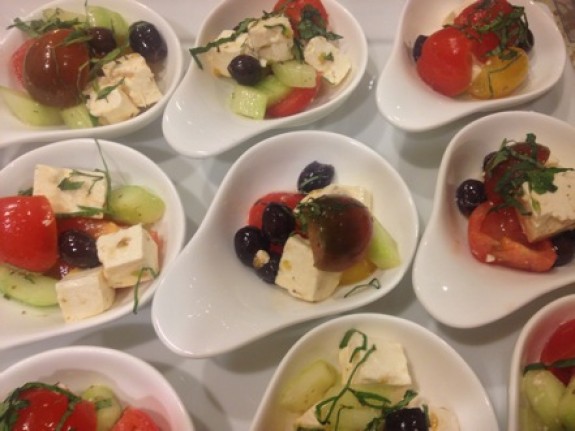
Greek Salad with Heirloom Tomatoes as interpreted by Four Seasons Hotel Executive Chef Douglas Anderson
Greek Salad with Heirloom Tomatoes
From Diet Simple Farm to Table Recipes: 50 New Reasons to Cook in Season!
8 servings
Ingredients:
Vinaigrette:
2 Tablespoons Freshly Harvested Extra Virgin Olive Oil
2 Tablespoons Freshly Squeezed Lemon Juice (1 Lemon)
1 Tablespoon Chopped Fresh Oregano or Basil (or 1 tsp dried)
1 Clove Garlic, Minced (optional)
Salt and Pepper to Taste (Salt is not necessary with the cheese and olives)
Vegetables:
2 cucumbers, peeled, seeded and sliced into a half-moon shape
1 onion, peeled and chopped coarsely
1 medium yellow, purple or green bell pepper, cored, seeded, chopped into large bite-size pieces
1 cup pitted Kalamata or other Greek Olives
4 Heirloom Tomatoes, quartered, and cut into large, bite-size pieces
4 ounces Feta or Goat Cheese, broken into small bits
Instructions:
Combine the vinaigrette ingredients in a large salad bowl and whisk until blended. Add the cucumbers, onion, pepper, and olives and toss into vinaigrette. Let sit for twenty minutes to marinate. Add the heirloom tomatoes and cheese when ready to serve.
Tomatoes are one of the “superfoods.” Men who consumed 10 or more servings of tomato products a week had a 35% decrease in risk of prostate cancer relative to those who consumed 1.5 servings or fewer per week. This is largely attributed to “lycopene” in the tomatoes, which is also in other red fruits such as watermelon, pink grapefruit and guava. Men with lycopene levels in the top 20% had a 46% decrease in risk of heart attack compared to those in the bottom 20%. Lycopene is a potent scavenger of gene-damaging free radicals. But don’t expect to get it from a supplement. You must eat the tomato as you need the whole food to receive the benefits! Here’s an explanation…
Lycopene (Red fruits such as tomatoes, watermelon, guava): Many studies have shown that lycopene-rich foods reduce the risk of prostate cancer, but the mechanism behind that reduction was not well understood until now. A recent study found that lycopene has a substantial protective effect against prostate cancer by interfering with the genes that would allow the prostate cancer cells to grow and survive. The American Institute for Cancer Research recommends that men take advantage of lycopene’s cancer-preventing effects and fill their diets with foods such as tomatoes, watermelon and guava.
- Bottom line: Fill your diet with lycopene-rich foods such as tomatoes, watermelon, and red grapefruit. Remember—the cancer-fighting properties of lycopene in tomatoes are much stronger when the tomatoes are cooked, such as in marinara sauce or tomato soup.
Fighting the Freshman Fifteen
- At September 03, 2013
- By Katherine
- In Articles, News
 0
0
Any change in your life: Leaving home for college, Getting a new job, Getting Married, Moving… Disrupts your healthy routine. It’s important to be aware of these habit changes so you can protect your health and healthy weight!
Melissa is 19 years old and spent her first year at college gaining about 15 pounds. She was pretty miserable when I first met her in June. But, thankfully, we spent the summer working together to lose the weight and she’s exactly where she wants to be before returning. At 5 foot 1, she now weighs in at a very reasonable 115 pounds. Melissa is thrilled with her new body. She feels more confident, more energetic, and happier than she did before—and she can finally wear skinny jeans!
But Melissa’s weight gain is not unusual. A 2003 Cornell University study found that college freshmen gain an average of 4 pounds in just the first 12 weeks. Some contributing factors include: all-you-can-eat buffets for breakfast, lunch, and dinner; late-night study sessions, which beget late-night snack fests; alcohol—and lots of it; a heavy course load that leaves little time for physical activity; and on and on.
Some factors adding to this weight gain are…
- Being faced with all-you-can-eat buffets at breakfast, lunch and dinner,
- Late-night studying – and the snacking and eating late which inevitably goes along with it… fattening take-out dinners of pizza or Chinese food,
- Alcohol- and lots of it,
- Pressure to take too many classes so precluding physical activity in the regular routine,
- Skipping breakfast or lunch time, then overeating between meals and later in the day and into the night.
I understand the struggle: I’ve been there. My weight gain occurred during my sophomore year—my first year away from home. I ate all my favorite foods any time I wanted (ice cream, pastrami sandwiches, chocolate chip bars, chips). And I went from being very physically active in high school—cheerleading, dancing, and more—to doing virtually nothing in college. I was getting flabby—and fast. I distinctly remember complaining to my grandmother how tired I felt. Her unsympathetic admonition,”You’re too young to feel this tired!” shocked me into action and I immediately started changing my ways.
For Melissa and other students going back to school this fall, the temptation to return to unhealthy habits will arise. You’re up to the challenge. Try these tips:
• Figure out when to fit in a healthy breakfast, lunch, and dinner. Skipping meals can promote overeating.
• Determine when you can be physically active. For instance, will you be able to get your physical activity by walking to and from classes on certain days? Will you need to hit the gym on others?
• Wear a pedometer to ensure you’re getting at least the daily 10,000 steps it takes to maintain your weight—and more if you want to lose weight.
• Sign up for an exercise class for credit. During my later college years, I took scuba diving, rescue diving, deep diving, tennis, fencing—basically, anything that allowed me to get credit for staying active and learning a new and interesting sport. This is also a way to meet other people with similar interests.
• Schedule your routine so that you are not hungry at night. If you must study late into the night, drink diet sodas or green tea (my favorite is Jasmine scented), and munch on fruits and veggies.
• Dump friends (subtly, of course) who push you to overindulge.
• Cultivate friendships with healthier folks who share your commitment to staying in shape.
You don’t have to undo your hard-earned summer results.
College weight gain is not inevitable!
4 Steps for Strengthening Muscles: Some Surprising News
- At August 21, 2013
- By Katherine
- In Articles, News
 14
14

I’ve been asked to share my personal regimen. Well, here it is – throughout the article, but also, look at the very end… Along with some personalized strategies for YOU!
One of my 50-something clients, who lost twenty pounds with a few “Diet Simple” tricks, increased pedometer steps, and weight training, confided in me that she feels sexy for the first time in years! On the tennis court, she performs better, is more flexible, stronger and quicker. Who could ask for more in your 40s, 50s, 60s – or even older?
My clients regularly ask me, “How do I maximize my workouts to gain muscle as quickly and effectively as possible?”
My answer: “What you eat and when you eat it profoundly improves your ability to build muscle mass and strength, and new surprising studies show an ancient beverage and a simple stretching routine can make a huge difference, too. Let me explain…”
1. Your Workout
While nutrition is important, the quality of your strength training workout is a key factor for building muscle mass. The National Institute on Aging recommends strength training all of your major muscle groups at least three times a week for 30 minutes. I encourage all my clients to get some kind of strength training so that when they lose weight, they not only look more toned and have more strength (who wants to be a flabby skinny person?), they’re healthier. This can be accomplished by working with a skilled trainer, but also through vigorous yoga and pilates – whenever there is resistance and you work your muscles to exhaustion – that is, you can’t do just one more pushup – you’re building muscle.
It’s also important to build muscle because the more lean muscle you have, the more calories your body burns because muscle mass increases metabolism. That’s why a man who weighs the same as a woman can eat so much more, and will lose weight more easily. He has relatively more muscle so he burns more calories, even at rest!
Studies of 80-year-olds show muscular strength can mean the difference between independence and a nursing home… it improves balance, walking, and reduces falls.
But it’s not easy to build muscle for a variety of reasons.
First, muscle mass declines as you age, starting in your mid 30s. An average person will lose five to seven pounds of muscle between age 35 to age 50 due to disuse. For every pound of muscle lost, you lose the capacity to burn 35 to 50 calories per day. That means if you’ve lost seven pounds of muscle by the age of 50, at 50 calories per muscle, that’s 350 calories you can’t eat just to prevent weight gain, let alone lose weight.
Second, weight loss causes muscle loss. When you lose weight, about half of what you lose is muscle -though you can minimize muscle loss by eating right (so read on!). This makes it even harder to keep the weight off because you’re reducing your muscle and therefore your metabolism as you lose pounds.
This brings us to the obvious: Building muscle as you age, eating the right kinds of foods to make that happen – and to minimize muscle loss as you lose weight – is essential to keeping lean.
Now for the nutrition…
2. Protein
Protein is essential for healthy living. It is one of the most important nutrients in the human body, second only to water. Bone health, muscle function, muscle strength, muscle mass and immune function — all are impaired with a low protein intake. But how much protein do we need?
New research has found that eating the right amount of protein – and at the right times – is essential not only for your health, but also for effective muscle gain and weight loss. Eating enough protein while losing weight is more likely to minimize muscle loss and maximize fat loss. Keeping muscle stores high is critical as losing muscle decreases resting metabolic rate, making it harder to maintain a healthy weight and lose body fat.
The National Academy of Sciences, in a recent report, recommended Americans eat at least 15% of their calories as protein but never exceed 35 percent, as that may be when adverse symptoms begin to appear (Low carb diets are often as high as 80% protein, and have many adverse health consequences).
If you’re losing weight or are worried about muscle or bone loss, consider increasing your protein.
How Much Protein? A personalized formula: The studies of aging populations find about 1.2 grams of protein per kilogram of (2.2 lbs is 1 kg) helps to reduce age-related muscle – and bone – loss. This amount should also be adequate for you to maximize your workouts, especially if you are in your mid-30s or older. Though some in the body-building community believe you can go as high as 1.6 grams of protein per kg of body weight. You may also need this higher amount if you’re sick or bed-bound to minimize muscle loss.
Example: So, if you weigh 150 pounds, this means the amount of protein you should eat is: 150 lbs (divided by 2.2 lbs per kilogram) = 68 kg; 68 kg X 1.2 grams of protein per kg of ideal body weight = 82 grams protein daily. For the maximum amount of protein, multiply 68 kg X 1.6 grams of protein per kg = 109 grams of protein per day
Where Do I Get Protein? Protein can be found in a wide range of foods. Animal protein is in seafood, lowfat dairy, poultry and eggs. Vegetarian protein can be found in legumes, soy, vegetables and grains. And while it’s true that high-protein foods often bring fat and calories along as uninvited guests, it doesn’t have to be that way. The lowest-calorie animal protein sources are the leanest. Go for seafood or poultry with no skin. Skim/lowfat milk, nonfat/lowfat yogurt, lowfat cheeses are also great options. Soy products also provide great low-calorie options and are high quality proteins similar to meat.
Toss four ounces of poultry or seafood or 12 ounces of spiced tofu into your salad and gain 28 grams of high-quality protein and no more than 150 to 200 calories.
8 ounces milk/yogurt: 8 grams protein
8 ounces Greek Yogurt: 20 grams
1/2 cup cooked beans/tofu: 8 grams protein
1 ounce fish/chicken/cheese (the leaner the meat, the more protein and the fewer calories): 7 grams protein
1 large egg: 7 grams protein
1/2 cup cooked or one ounce dry (1 slice bread) grain: 3 grams protein
1/2 cup cooked or one cup raw vegetables: 2 grams protein
3. Timing is Everything!
Eat a food or beverage high in protein (with some carbohydrate) 20 minutes before, and again, immediately after your strength training workout or after a vigorous cardiovascular workout, such as tennis, swimming, or kayaking, or even just a long walk. When you work out, you break down your muscles. Taking in protein when your muscles are being broken down and are metabolically active will build your muscle mass and strength more effectively. You also need to make sure you hydrate yourself properly!
My personal regimen includes drinking some skim milk before my workout – all you need is about 1/2 cup – and eating yogurt immediately after my workout or after yoga. If I forget the yogurt, I’ll run to the nearest coffee shop after my workout and buy a skim latte for my protein, which contains milk, or soy milk. But, I like yogurt the best: It contains important probiotics which keep your gastrointestinal tract healthy. It also contains high quality protein, carbohydrate, calcium, potassium and magnesium – important nutrients which you need to replenish your muscles. Eating immediately after your workout could have other benefits: It prevents the “extreme hungries” some people feel after heavy exercise, and it could prevent muscle cramps, according to a client who used to have muscle cramps regularly until she started eating yogurt after her exercise.
Current thinking among protein researchers is that protein is most bioavailable for your muscles (and your cells and organs) if eaten in relatively small quantities through the day. For women, 20 grams per meal is what the body can utilize efficiently. For men, that can go up to 30 grams per meal. So, with my personal protein goal being 60 grams per day, I’m sure to have about 20 grams in the morning, 20 grams mid-day and about 20 grams in the evening, as my body may not benefit from more at one sitting.
If you’re a man who needs 100 grams per day, you could spread out your protein intake through the day to 4 meals – separated by at least two hours – of about 25 grams each. So an 8 ounce steak at night, containing 56 grams of protein, just won’t cut it!
A new study found tea improves muscular strength. Tea? Apparently, as we age, oxidative stress and inflammation cause age-related muscle and bone breakdown. Tea’s healthy compounds, called “polyphenols,” reduce oxidative stress and inflammation, preventing this breakdown, and even improve muscular strength and bone mass. In a recent study funded by the National Institutes of Health’s National Center for Complementary and Alternative Medicine, when post-menopausal women with osteopenia (the beginning of osteoporosis – brittle bones) were given tea and/or Tai Chi exercises, after six months, the tea alone caused an improvement in muscle strength and bone-building biomarkers. Learn more about the health benefits of tea… So did the Tai Chi alone – certainly not a rigorous or impactful exercise, which we’ve been taught all along was necessary for muscle and bone building! Apparently, Tai Chi also reduces inflammation and oxidative stress.
With the amazing results of this study in mind, it makes sense that any foods high in anti-oxidants and anti-inflammatory compounds, such as fruits and vegetables, may help improve bone and muscle strength. And, if Tai Chi helps improve bone and muscle mass, shouldn’t other forms of meditation or meditative exercise, such as yoga? More research is needed to establish the facts, but these results certainly are promising.
See more specifics of my own personal regimen below!

KT walking in the’hood! In addition to some facts about my own regimen written throughout this article, read more about my personal regimen below… (Photo by Zach Lipson)
In the meantime, I’m drinking tea every day, doing vigorous yoga at least 2 to 3 times a week, working with a trainer once a week, walking A LOT to keep body fat down, at least 10,000 pedometer steps is a daily average, in my posture-improving MBT shoes, from Comfort One Shoe Store (ask for Manager, Shawn O’Neill), eating plenty of yogurt, and my own delicious batch recipes filled with healthy foods found in Diet Simple and Diet Simple Farm to Table Recipes (only $4.95) to keep my muscles and bones strong, and my body in shape!
Obesity Rates Declining? Nothing Short of Miraculous!
- At August 10, 2013
- By Katherine
- In Articles, News
 0
0
I was asked by the newly launched Washington Post TV’s “On Background” to discuss last week’s news reports of the first decline in childhood obesity in decades. Childhood obesity decreased in 19 states, according to the latest Centers for Disease Control data. This modest decline is nothing short of miraculous because overall, America’s food and physical activity environment seems worse than ever. Calorie-dense snack foods and fast foods are everywhere – easily and cheaply available. Children and adults spend even more time sitting in front of computers, televisions, in classrooms and cars than just a few years ago. This reversal means families, parents, caretakers, teachers, and schools are making huge efforts to overcome these negative influences.
Reversing obesity in our culture, where overweight is the norm (2 out of 3 adults and 1 out of 3 children are overweight or obese), takes effort ; it’s not an accident! Adults are making better – harder – choices for children. Americans may be slowly internalizing the need for healthy eating and exercise. Just as smoking was once considered normal adult behavior, we’re gradually realizing that mindful meals and physical activity must be made a societal norm. And that’s great news… for children, for their families, and for our country, which spends billions of dollars annually on obesity and its related diseases, including type 2 diabetes, heart disease, cancer, and more.
“Obese children are more likely to become obese adults and suffer lifelong physical and mental health problems,” according to the CDC. “Obesity rates in low-income preschoolers, after decades of rising, began to level off from 2003 through 2008 and now are showing small declines. However, too many preschoolers are [still] obese,” continued the report.
Are you dangerously overweight? Find out by checking out my 8 Steps!
Some reasons given for the successful reversal of obesity:
It seems small, simple changes have been responsible for this amazing improvement in the health of children. The power of small changes is described in my Diet Simple chapter: “Easy Solutions for Your Kids,” with tons of ideas easily integrated into your family life. Just adding fruits and/or vegetables at each meal or 15 extra minutes of daily physical activity can make a huge difference in a child’s health and weight. For fun, easy recipes and tips, buy Diet Simple: 195 Mental Tricks, Substitutions, Habits & Inspirations, and for more recipes, buy Diet Simple Farm to Table Recipes.
Katherine Featured on CBS Evening News, 2010
Are you dangerously overweight? Find out by checking out my 8 Steps!
Katherine’s Ten Commandments for Flat Abs This Summer
- At July 31, 2013
- By Katherine
- In Articles, News
 1
1

Katherine Presenting "Achieve Your Ideal Health and Weight While Juggling Your Crazy, Busy Life!" exclusively for the Four Seasons Spa
Have you relegated your best suits, bathing suits and skinny jeans to the dark recesses of your closet? Aren’t you tired of going undercover every summer to avoid exposing your less-than-supple body? Wouldn’t it be nice to have beautifully defined arms, legs, and a flatter belly?
So, before you dump on (or just plain dump) your workout for not giving you killer abs and the slim body you dream of, you should know the real culprit could be your diet-and even your high-stress lifestyle.
When it comes to going from fat to flatter abs, new research shows that what you eat is just as important as how–or even how much– you work out. And lifestyle counts, too, because while stress doesn’t just mess with your head-it can also induce a pooch. And that killer work-out? It may not be slimming your body the way you hope!
As a longtime weight-loss specialist, I can assure you that a slim body and flat abs aren’t an impossible dream or something seen only on fitness models. In fact, I’ve helped thousands of people (myself included) whittle flabby middles into beautiful flatter bellies by combining an eating plan especially designed to decrease fat and bloating with aerobic exercise, strength training and stress management.
With my plan, you’ll build a show-off body that is the center of attention when you’re wearing a fitted business suit, a bathing suit, a pair of skinny jeans–or nothing at all!
Let’s Get Started … with Katherine’s Commandments…
I. Diet Simple Tip #77: Do Some Calorie Shifting
Americans traditionally eat a large dinner – one that we attack with zeal. Is it any wonder we gain so much weight? Rearrange your days’ calories so you’re eating one third in the morning, one third mid-day and no more than one third at night. For most of you, that means you’ll be eating a larger breakfast – about 600 to 700 calories, and a lighter dinner than usual.
Bottom Line: Lose 30 pounds
Eating relatively light dinners at night, and shifting more of the calories to breakfast and lunch – so that you’re eating 2/3 to 3/4 of your calories before dinner – and you arrive at dinner just barely hungry, can easily save you 300 calories a day
II. Diet Simple Tip #28: Shop at the Farmers’ Market
I’ll never forget my Grandmother’s home-grown tomatoes. They were soft, plump, sweet, deep red, and still warm from the day’s sun – the kind you only get fresh from the vine. At your farmers market, you’ll find fruits and vegetables picked at peak ripeness, which means maximum flavor, texture, and nutrition. And when food tastes better, you eat more. That’s a SCIENTIFIC FACT!
Bottom Line: Lose 36 pounds
Adding salads, vegetable soups and fruits to your daily meals will help you cut back on other more fattening foods. Studies show starting each meal with a salad saves at least 100 calories – and that’s without dieting! For a summer treat, try my Gazpacho or Cool Cucumber Soup… in my new Diet Simple Farm to Table Recipes
III. Diet Simple Tip #36: Hit the Ground Running
No one believes me when I tell them they can burn 600 calories before work or before even waking up! They’re even more surprised when I explain that’s the best way to do it. Try this: Wake up in the morning. Yawn. Roll out of bed, go to the bathroom, have a drink of water, and slip on some exercise clothes. Start moving. Right away! Exercising first thing in the morning is one of the best things you’ll ever do for yourself. And before you know it, it’s over with before you’re even awake!
Bottom Line: Lose 28 – 42 pounds
All it takes is thirty minutes in the morning: just walking briskly will burn up to 28 pounds in a year. Another great thing about morning exercise: no midday heat to contend with. Wear a pedometer and make sure you’re getting at least 10,000 steps a day. Men LOVE the Nike Fuel Band… Women’s favorite: the Fitbit!
IV. Diet Simple Tip #43: Listen When You Chew
Actually, you don’t have to go that far. But you should focus your entire attention on your food so you enjoy and savor every bite. When you eat on autopilot, when your mind is somewhere else, you don’t enjoy your food very much. More important, “mindless” eating generally turns into overeating and doesn’t provide physical or psychological satisfaction.
Bottom Line: Lose 21 pounds
Once you start focusing your attention on the food in front of you – relax and take a few deep breaths before eating – you’ll almost automatically eat a little less. In fact, even if you leave only a few extra bites on your plate, it could add up to a savings of 200 or more calories daily
V. Diet Simple Tip #45: Write it and Lose It
The food diary is the main tool for self-examination of your eating habits. Socrates told us that the road to wisdom is to know ourselves. This is never more true than in your eating habits.Research shows self-monitoring – keeping a food journal in this case – is the most highly correlated behavior for successful behavior change and weight loss.
Bottom Line: Lose 23 pounds
If keeping a journal enhances your attentiveness and helps you eat less here or there or even think twice about that vending machine candy bar, you could save 220 calories per day.
VI. Diet Simple Tip #76: Fight the Beast
Hunger is pretty rational. It tells you when you need to eat and when you’ve had enough. Cravings, on the other hand, are cruel and capricious. They always demand more, more, more! Using a scale of 0 – 10, rate your body’s hunger signals before and after eating.
Bottom Line: Lose 30 pounds
If you listen to your body signals and regularly eat when your stomach says you’re hungry and stop when you are no longer hungry, before you are too full, you save at least 300 calories a day.
VII. Diet Simple Tip #103: Cook More Than You Can Eat
A strange suggestion to find in a weight loss book? Believe it or not, it’s among the best approaches for shedding extra pounds because the foods you cook today become nutritious leftovers for later. Having delicious, healthy food at your fingertips when you need it can save you hundreds of calories each and every day because you’ll be less likely to irrationally grab high-calorie restaurant or to-go meals and fattening snacks.
Bottom Line: Lose 30 – 42 pounds
A meal cooked at home, including those delicious leftovers (“Batches” in Diet Simple), can save you 300 to 400 calories at dinner. Get tons of ideas in my new Diet Simple Farm to Table Recipes.
VIII. Diet Simple Tip #132: The 25 Percent Blowout
During a summer vacation, you might find yourself invited to four parties in a week. Go to all of them – and indulge at ONE. Here’s some rocket science: What happens when you go to four or five parties or restaurants in a week, and eat yourself silly at each one? You’ll make a good social impression, but the impression on the scale at the end of the week will be even more impressive.
Bottom Line: Lose 9 pounds
No matter how much you eat at a special event, remind yourself that you saved at least 600 calories at the other end where you practiced self-control. If you do a similar thing throughout the summer, you can plan on saving a whopping 31,000 calories!
IX. Diet Simple Tip #185: Fish For Health
After all this talk about the dietary dangers of meals out, I think it’s worth mentioning one standard entrée, seafood, that always pays off. Seafood starts out so lean and low in calories that even when the dish is drenched in butter, the result won’t bust your buttons.
Bottom Line: Lose 22 pounds
A comparison: One 16-ounce prime rib has 1,300 calories. The baked potato and sour cream is 330. Oh, and the Caesar salad? 310! If you order grilled seafood and vegetables instead, you’ll save about 1,500 calories – and that’s just in one Saturday night!
X. Diet Simple Tip #1: The Sundae Solution
Now it’s official: You can eat a chocolate sundae every day and still lose weight!
Bottom Line: Lose 9 – 35 pounds
A tablespoon of regular chocolate syrup has about 50 calories. Pour it over fruit, and your total is about 110 to 160 calories. Compare that to the usual snacks – a candy bar has about 250 calories, and an ice cream cone has about 500 – and you can see why substituting the ice cream with fruit in your sundae can lead to impressive amounts of weight loss. Make the switch every day, and you can count on losing nine to 35 pounds in a year.

